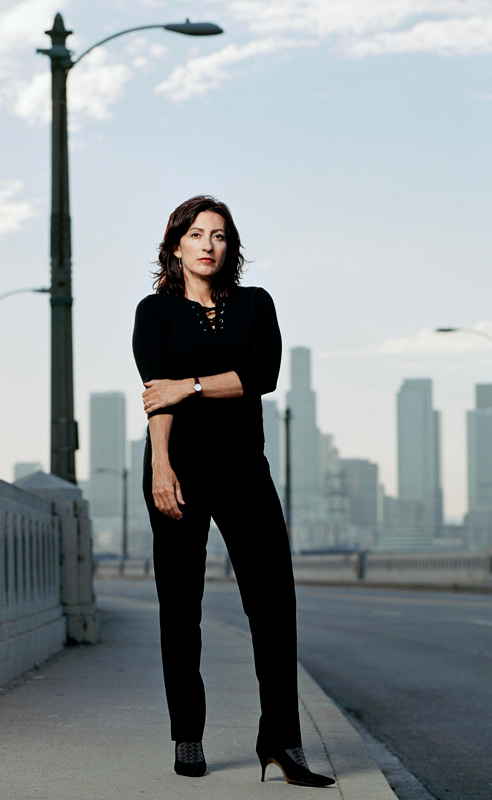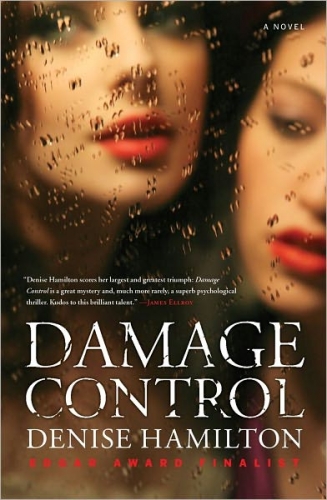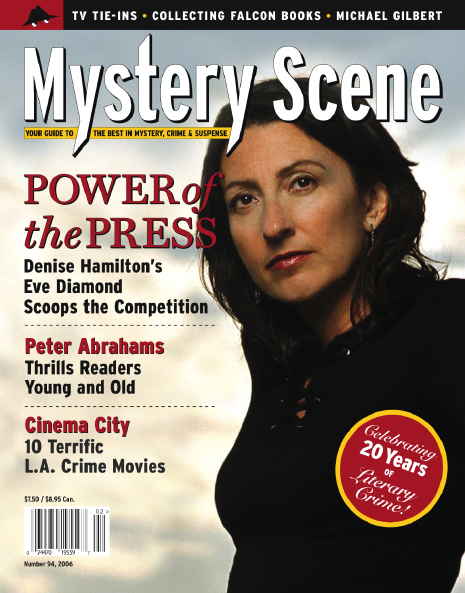 Hamilton's Journalist Eve Diamond Hits the Streets of Los Angeles
Hamilton's Journalist Eve Diamond Hits the Streets of Los Angeles
Photo: Blake Little
"I see Los Angeles as this huge puzzle that's a sprawling chaos, that has a lot of beauty and lyricism as well as devastation and horror."—Denise Hamilton, whose latest, is standalone Damage Control (September 2011).
Writing about your hometown should be a snap. After all, this is the place where you grew up, attended school, worked, and are now raising your children. There can’t be that many secrets or hidden nooks and crannies left to find.
Unless your hometown is Los Angeles, a city that is in constant flux, that invests new meaning in the word diversity, and where urban sprawl spawns millions of stories.
That’s the challenge—and opportunity—that author Denise Hamilton faces each time she writes a novel in her series about Eve Diamond, a reporter for the Los Angeles Times. Los Angeles provides the perfect background as Diamond’s beat takes her into the various hearts of the City of Angels. But just as Diamond is constantly learning about L.A., the author is also always discovering new things about her hometown. A book signing across town is a chance to drive unfamiliar roads; a child’s birthday lets her visit a new neighborhood; an invitation to lunch becomes an entrée to a new ethnic restaurant.
It’s all fodder for the Eve Diamond novels in which Los Angeles is as important as the heroine. As a former reporter, Hamilton knows that being a journalist provides a special invitation to see sides of the city off the beaten path.
“When you’re a reporter, every day is a different short story unfolding before your eyes,” said Hamilton, whose fifth novel, Prisoner of Memory, is hitting the bookstores.
“One day you might be sent to interview Vietnamese immigrants, the next day a celebrity, and everyone in between. Being a reporter is a passport to travel through the warp and woof of L.A., to see every neighborhood, class, culture, and enclave. With my books, I’m trying to document the L.A. that I see. And it’s an L.A. that’s evolving and changing even as I write about it.”
 While a plethora of mystery writers plow Los Angeles for their stories, and bookshelves are filled with the work of reporters turned novelists, Hamilton’s novels open a window into new worlds, uncovering unusual tales.
While a plethora of mystery writers plow Los Angeles for their stories, and bookshelves are filled with the work of reporters turned novelists, Hamilton’s novels open a window into new worlds, uncovering unusual tales.
Her 2001 debut The Jasmine Trade introduced “parachute kids,” rich Asian teens who live alone in California while their parents run businesses in Hong Kong. It was shortlisted for the Edgar Award for Best First Novel, the Macavity, the Anthony, the Creasey Dagger Award, and the WILLA Award for contemporary fiction.
Sugar Skull enfolded stories about the Mexican-American community and its music with the phenomenon of upper-middle class and wealthy girls seeking out homeless "squatter" boyfriends.
Last Lullaby, named a “Best Book of 2004” by the L.A. Times, a USA Today Summer Pick, and a finalist for the Southern California Booksellers Association’s best mystery award, tackled the vagaries of immigration and drug smuggling.
Savage Garden, a 2005 finalist for best mystery by the booksellers association, explored the theater scene via a playwright whose former life as a gangbanger threatens his new success.
And Prisoner of Memory is set among L.A.’s Russian immigrant community.
It’s no accident that the theme of L.A.’s ethnic diversity courses through Hamilton’s novels. She grew up in North Hollywood, the eldest daughter of an Irish-American roofing contractor and a Russian-French nurse. At home, the family spoke French and English.
“My mother was an immigrant,” said Hamilton, 46. “I always felt a slight tilt against traditional American culture because I had that overlay of European culture and another language....Plus, as a reporter, you have to hold yourself apart and not get too involved. That gave me an outsider’s eye, always peering into L.A., trying to puzzle it out and decipher it.”
Multiculturalism continues to be a part of Hamilton’s daily life. In her son’s class at school alone, the student body reflects more than ten cultures, children who also are growing up speaking different languages at home. Hamilton’s husband is a first-generation Mexican American, and his mother lives with them, so the family also speaks Spanish at home.
“In this city, the majority is minority. It’s not hard to interact with people from different races and cultures.”
 Journalism, not novels, had been Hamilton’s career goal. She spent ten years at the Los Angeles Times where she started as a summer intern. She had planned to become a foreign correspondent based in Moscow. She gained foreign reporting experience through two traveling fellowships, including a Fulbright, that took her to Hungary and the former Yugoslavia during the early 1990s in the midst of the Bosnia war.
Journalism, not novels, had been Hamilton’s career goal. She spent ten years at the Los Angeles Times where she started as a summer intern. She had planned to become a foreign correspondent based in Moscow. She gained foreign reporting experience through two traveling fellowships, including a Fulbright, that took her to Hungary and the former Yugoslavia during the early 1990s in the midst of the Bosnia war.
Her career plans changed when she started a family with her husband, David Garza, to whom she’s been married for 12 years. During the mid-1990s, the L.A. Times began what is now too often a regular occurrence at newspapers—it started offering employees buyouts. Hamilton was six weeks pregnant and had been doing a lot of re-evaluation of her job.
“I wondered what would happen if I had a baby and had to cover an earthquake.” So she took the buyout and remade herself into a freelance journalist. “I thought if I do this, it will either be the best or the worst thing.” And she didn’t have to look too far for work. “A Friday was my last day, but by Monday I was back freelancing for the Times,” said Hamilton, whose work also has appeared in Wired, Cosmopolitan, Der Spiegel, and New Times.
She also began writing bits of The Jasmine Trade, because the story about the parachute kids that she had covered as a reporter had never left her mind.
“I had to have the psychological distance from the newsroom to dig into a book and write it without [newspaper] editors looking over my shoulders and thinking Eve is me,” Hamilton said of the novel that would become The Jasmine Trade. “I also needed the psychological distance to allow myself to let Eve do what she does.”
In addition to the depiction of L.A.’s subcultures, Hamilton’s series takes a hard look at journalism ethics, newsroom politics, and how newspapers have become more corporate. Although she’s been away from a daily newsroom for more than a decade, working journalists view her novels as realistic, authentic looks at the profession.
“The psychology of the newsroom offers lots of conflict that’s put to good form in this series,” said Hamilton, who still keeps in touch with friends who are in the business.
Often readers, especially journalists, tell Hamilton they are convinced that Eve’s fictional editors, colleagues, and situations are based on real counterparts. They aren’t.
“Fictional characters can take on a life of their own; the emotional reactions of situations can bubble down to the fiction. I want to recreate the feel of the newsroom and the tensions of the editor vs. the reporter. But also, Eve has editors she adores and that’s also realistic.”
 For those wondering how close Eve Diamond is to being Denise Hamilton’s alter ego, well, the novelist and the character share more than a profession but the novelist doesn’t mistake her character for herself.
For those wondering how close Eve Diamond is to being Denise Hamilton’s alter ego, well, the novelist and the character share more than a profession but the novelist doesn’t mistake her character for herself.
“She’s my wilder alter ego. She takes things to the next level. She does things that I would never have done from a journalistic ethics point of view. She dodges more bullets than I ever did, collars more bad guys than I ever did, and she saves more people than I ever did.
“She’s the super-journo. So much of journalism is work-a-day and boring. It’s very rare that you get into a situation that is dangerous or morally dubious. Eve is flawed. She suffers from nagging insecurities and guilt and envy. I want to explore all those issues with her as a flawed vessel.”
There’s also a chance that Eve Diamond’s adventures may make it to the silver screen. The series has been optioned, Hamilton said, by Kathleen Kennedy, a producer affiliated with Steven Spielberg and whose credits include the Bourne movies, Munich, and Seabiscuit, among others. “The last I heard they were working on a script,” said Hamilton.
Meanwhile, Hamilton has just finished a spring book tour through England, Ireland, and Scotland. She’s also gearing up for her tour in support of Prisoner of Memory, which will take her to a variety of states, as well as a myriad of events in California. She’ll be the toastmaster at the seventh annual Mayhem in the Midlands in Omaha over the Memorial Day weekend.
While the fictional reporter has proved to be a real gem for Hamilton, the novelist also is planning to take a break from Diamond. Hamilton currently is putting the finishing touches on her first stand-alone novel that will revolve around the disappearance of a starlet in 1949. True to form, the city will be as important to the plot as the characters. She also will be editing Los Angeles Noir, a short-story anthology from Akashic Books, the publisher that began the city noir collections with Brooklyn Noir.
But Hamilton is not taking a break from Los Angeles
“I see L.A. as this huge puzzle that’s a sprawling chaos, that has a lot of beauty and lyricism as well as devastation and horror. L.A. is endlessly fascinating and endlessly inspiring. You almost never see the same thing twice. You can go to the same neighborhood two weeks in a row and see something different. Everything is so layered.
“It’s a city I never get tired of writing about or will run out of ideas about. All I have to do is step outside.”
 A DENISE HAMILTON READING LIST
A DENISE HAMILTON READING LIST
Damage Control (2011)
Los Angeles Noir 2 (2010)
The Last Embrace (2008)
Los Angeles Noir (2007)
Prisoner of Memory (2006)
Savage Garden (2005)
Last Lullaby (2004)
Sugar Skull (2003)
The Jasmine Trade (2001)
This article first appeared in Mystery Scene Spring Issue #94.


